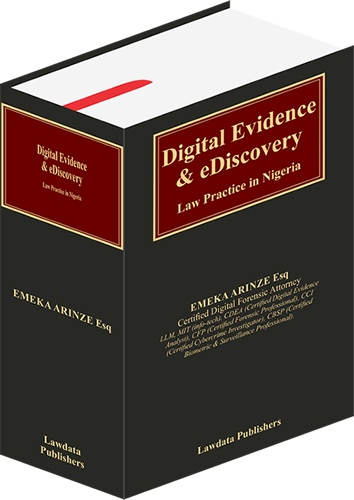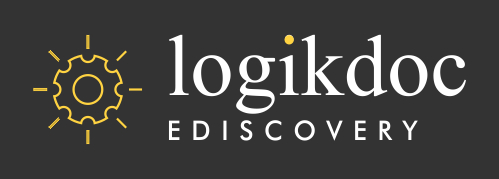Global Certification in Digital Fluency and Proficiency in Digital Evidence, Forensics, eDiscovery, and Law Practice Automation
For the Bar
Opening Statement
By Emeka Arinze Esq. - Course Convener.
Why Lawyers must be proficient in the rudiments of Digital Evidence, eDiscovery & Law office Automation
Before we begin this journey into information legal kaleidoscope, it would be a good idea to ponder on the following statements of the 21st century authors
“as we delve deeper into the information society kaleidoscope, unless there are proper guidelines expressly defined under relevant IT laws, one can expect a flood of difficult-to-resolve litigations capable of sending judges and lawyers back to school as they would, henceforth be dealing with disputes emanating from the essential components of computing systems in their courts, largely bordering on authentication of digital evidence pertaining amongst others, on online banking and payment system, digital signatures for transactions in the cyber space, email fraud, digital libel, digital medical issues of health, etc.” – Chris Uwaje, in his book “e-Knowledge-time is running out”.
“It is self-evident that as our society makes increasing use of electronic devices, such as computers and mobile phones, so the evidence that we rely on in litigation, both civil and criminal, will be increasingly electronic in nature. But central to this increasing use of electronic evidence are fundamental technical and legal questions about the quality of that evidence and the circumstances under which it can be obtained and then admitted into court.” – International Commentary on Evidence, Deirdre M. Dwyer
The above statements, anchored on the digital dynamics of the 21st Century, no doubt underpins the essence of this training, with its primary objective geared towards developing analytical skills to meet the challenge of legal practice inherent in the new world legal order.
However, in a world that has become increasingly digital and mobile:
- where cell phones work like ankle bracelets, acting as monitors that send radio frequency signals for location surveillance and other information to a receiver, tracking the movement of its carrier;
- where millions of people engaged in conversations, not at the local bars, but over keyboards in virtual communities (the social media);
- where digital tracks can be left on computers, phones, digital cameras as well as third party servers belonging to Internet Service Providers (ISPs), and companies that provide services via Internet such as YouTube, Facebook, Gmail;
- where computers not only contain the proof of crimes, but also an alibi for the defence;
- where documents or records of events are stored not just on computers but in the cloud,
the reality of the time poses critical challenge for the bar and the bench as they engage with discovery and evidentiary issues orchestrated by electronically-stored data and their respective uses in our courts, especially when the pre-digital evidence legal framework never envisaged nor contemplated a world anchored on the use of electronics and the electromagnetic spectrum to store, modify and exchange data via networked systems and associated physical infrastructure without regard to physical geography.
Such evidentiary issues raise certain fundamental questions on the evolution of digital evidence, eDiscovery and Law office & client portal automation.
It is obvious that no matter how knowledgeable a digital forensic expert (not also trained as a lawyer) engaged as an expert in providing expertise on technical issues in court, he cannot conduct an examination-in-chief, cross-examine a witness or re-examine a document custodian or computer forensic expert on the other side. This is the province of the lawyer.
For lawyers to engage in effective examination or cross examination of such expert witness in court, they must as a matter of necessity make effective effort towards understanding client’s use of technology, electronic data dynamics, methods, policies and procedures inherent in managing electronically-stored information (ESI).
The lawyer, at all-time material, should be prepared to defend his introduction of computer evidence against all objections and attack such digital evidence produced by opposing counsel where expedient. A working knowledge of the computer, the evidence it can generate, and the evidentiary questions raised, prove invaluable for the bar and the bench in today’s rapidly changing and increasingly automated society.
For the bar and the bench to fit into the emerging concept of digital evidence and eDiscovery and explore the potential knowledge inherent in digital data in streamlining the pre-trial and trial processes, they must in addition to their earlier legal training acquire skills across relevant disciplines.
The ability to apply skills across disciplines comes handy anywhere problem solving is required. To be relevant in this dispensation, the bench and the bar must have basic knowledge of adjacent and connecting fields so as to readily adapt and address the novel and complex problems that often arise.
Therefore, the 21st century bar and bench must possess the “I” shaped and “T” shaped quality skills. The “I”-shaped professional is highly versed in a specific area of expertise, whilst the “T”-shaped professional has broader skills and knowledge and learns by linking up different perspectives from different specialties. Although the bench and the bar have deep legal expertise, they must also have the ability to collaborate across disciplines such as technology and forensics.
It is against this background that this training is categorized into two platforms: foundational (preparatory) course to the certification course representing the second category.
Course Content
The course content comprises two major categories; (a) Foundational Course and (b) Certification Course
Foundational Course
This fundamental course is designed as an introductory course to the Proficiency Certification in Digital Evidence, eDiscovery Law Practice & Law Office Automation. It shall be dealing with foundational topics on the Virtual Reality Cyberspace and its occupants, the Digital World and its Ecosystem, and how it has disrupted the world as we know it today.
Certification Course
This course will cover topics on Digital Evidence & eDiscovery Law Practice; Digital Exhibit Management, Authentication, Security & Trial Presentation; and Law Office Technology, Practice & Client Management System.
Digital Evidence & eDiscovery Law Practice
If you have not yet been served with discovery requests seeking electronic documents or email, the chances are you will soon be. In the likely event you are served, what are your obligations in responding to discovery seeking electronic evidence? Do you possess the technological sophistication necessary to properly advise clients on what to do with regard to preserving electronic evidence once it becomes apparent that litigation is a possibility? When is it appropriate for you to request a computer forensic investigation? What is the current case providing guidance for the costs of producing electronic evidence and what are appropriate sanctions for not producing electronic evidence or failing to prevent it from spoliation? These questions and many more are answered in this topic.
This subject is covered in modules 1 to 22 of the certification course curriculum.
Digital Exhibit Management, Authentication, Security & Trial Presentation
ExhibitSecure offers an end-to-end cloud-based electronic Exhibit software and presentation solution that provides best-in-class services, that give law firms, corporations, and government agencies total control over their data, electronic exhibits, workflows that enable them collect, manage, measure, optimize, process, review, unifying all phases of electronic exhibit documentation through trial presentation during litigation.
This subject is covered in module 23 of the certification course curriculum.
Law Office Technology, Practice & Client Management System
AttorneysBrief is an industry-leading purpose-built, cloud-based solutions for small and medium-sized Legal firms to support a secure and cloud-enabled practice. Our highly differentiated cloud infrastructure puts customers’ business data and vital applications into a virtual workspace accessible anywhere, anytime, and from any device.
This subject is covered in module 24 of the certification course curriculum.
Learning Outcome
On completion of this course as espoused in the video, reading activity, quiz and assessment, participants will become proficient in the following:
-
Digital Evidence & eDiscovery
Digital Evidence, Forensics, eDiscovery, and Law Practice Automation
-
Office Automation
Understanding & Implementation of digital tools for office management, Library Automation and Client Portal
-
Litigation Automation
Automation of manual or routine tasks that lawyers carry out during litigation.
-
eDiscovery Compliance
Electronic Document Management and Trial Presentation of Digital Exhibits such as videos, biometric modalities, audios, still images, and texts in court
Course Features
- Weekly Modular Structure
- Notes & Videos
- Assignments
- Quiz
- Discussion Forums
- Assessments
Training Resource Tools




Course Curriculum
Chapter 1: Virtual Environment, Digital culture and the Dilemma of the Judicial Tripod in the 21st Century
Chapter 2: An Overview of the Law of Evidence: The Pre-Digital and the Digital Age, incorporating the Understanding of Integrated Circuits, Binary Digits & their Evidentiary Values
Chapter 3: Understanding Computer System Components, Functions and Their Evidentiary Values
Chapter 4: Digital Evidence Sources and their Evidentiary Values
Chapter 5: Admissibility Foundation for Digital Evidence
Chapter 6: Electronic Document and Admissibility Foundation
Chapter 7: Digital Images as Evidence
Chapter 8: Cellphone Data and Cellular Networks as Evidence
Chapter 9: Social Networks and Digital Evidence
Chapter 10: Satellite Image (Data) as Digital Evidence
Chapter 11: Electronic Banking and Evidentiary Challenges
Chapter 12: Legal Issues Specific to Deoxyribonucleic Acid (DNA) Forensic Evidence
Chapter 13: Logs as Digital Evidence
Chapter 14: Cryptography and Blockchain: The Backbone of Digital Evidence Authentication
Chapter 15: Chain of Custody: It’s Application to Digital Evidence
Chapter 16: Judicial Notice in the Digital Age
Chapter 17: System Malfunction and Integrity Violation: A Case for Section 84 of the Evidence Act, 2011
Chapter 18: Evaluation of Section 84 of Nigeria Evidence Act 2011 and A Critique of the Supreme Court Decisions in Kubor v. Dickson and Kubor v. Sylva
Chapter 19: eDiscovery: An Overview
Chapter 20: The Development of eDiscovery Guidelines, Reference Models/Legal Framework
Chapter 21: An Overview of eDiscovery Development and Application in Different Jurisdictions and Nigeria
Chapter 22: Litigation-Readiness Plan: Getting Ready for eDiscovery
Chapter 23: The Preservation of Evidence and Litigation Hold
Chapter 24: Pre-Trial Conference and Early Exchange of Computer System Information Pursuant to eDiscovery
Chapter 25: Production of Electronically Stored Document
Chapter 26: Accessibility and Inaccessibility Issues in the Production of Electronically Stored Information
Chapter 27: The Principle of Proportionality in Producing Electronically Stored Information in eDiscovery
Chapter 28: Spoliation and Sanctions
Chapter 29: Subject-Specific Sources of Discoverable Electronic Stored Information in eDiscovery
Chapter 30: Freedom of Information Act (FOIA) 2011: Access to Information in the Age of Electronic Record
Chapter 31: The Basic Concepts and Locard Exchange Principle in Digital Forensic Investigations
Chapter 32: Investigators, Prosecutors and Defence Counsel Familiarity with Basic Computer Concepts and Resources
Chapter 33: Locating and Protecting Electronically-Stored Data in Digital Investigation
Chapter 34: Digital Forensic Investigative Tools
Chapter 35: Search and Seizure in Digital Forensic Investigation
Chapter 36: Digital Forensic Investigative Methodology and Techniques
Chapter 37: Application of Digital Forensic Investigative Technique: A Case of Money Laundry in Nigeria
Chapter 38: Cybercrime: Evidentiary Issues in Prosecution and Defence in Consequence of Digital Forensic Investigation
Chapter 39: The Emergence of Expert Witness, the Concept of Expert Opinion and Common Knowledge
Chapter 40: Duties and Responsibilities of Expert Witness
Chapter 41: Ethical Issues and Disqualification of Expert Witness
Chapter 42: The Expert Witness Report
Chapter 43: Admissibility of Forensic Expert Evidence in Court
Chapter 44: Digital Forensic Expert Witness in Court
Digital Exhibit Management, Authentication, Security & Trial Presentation
Law Office Technology, Practice & Client Management System
Convener

